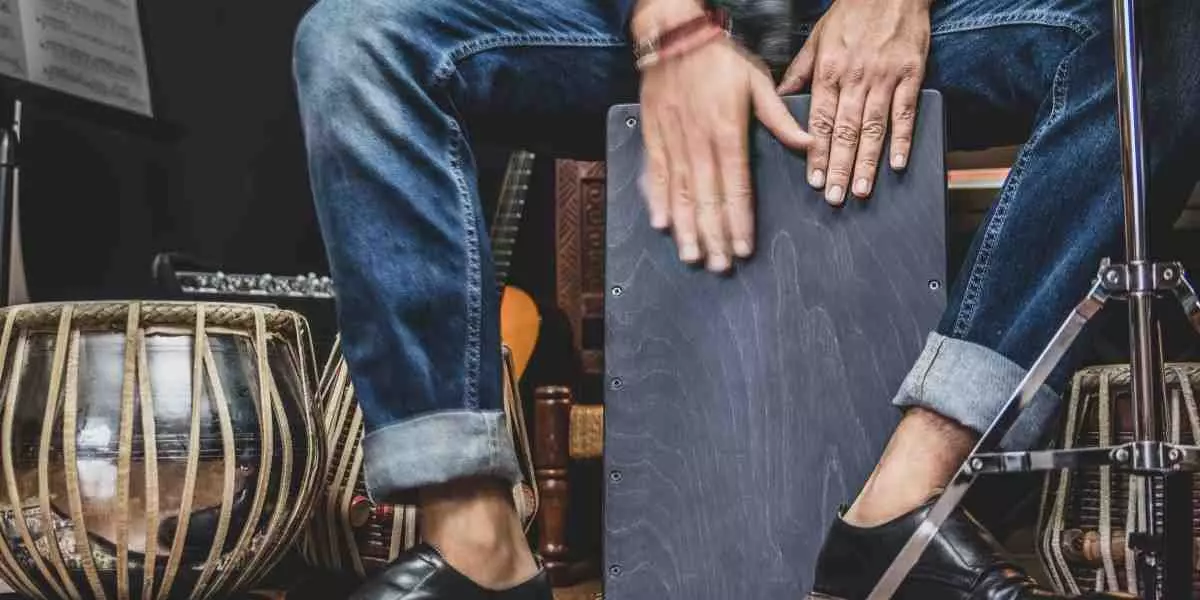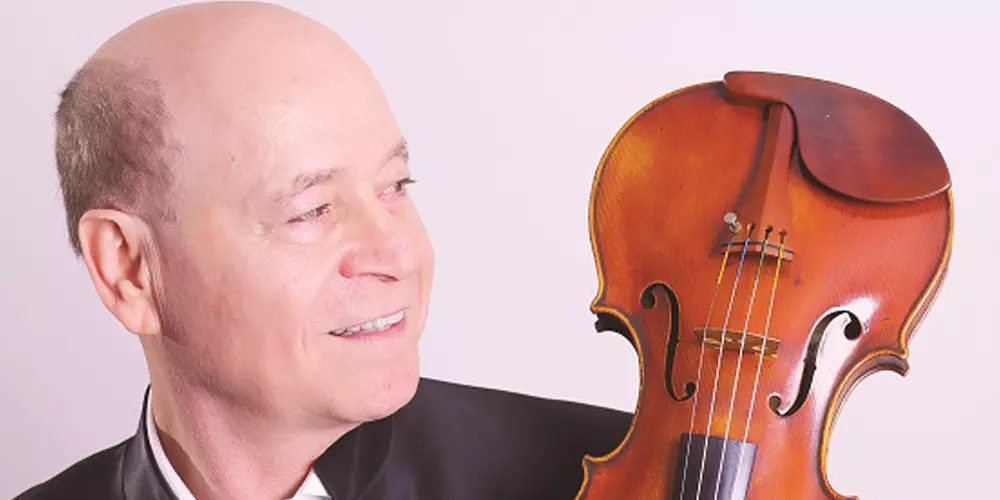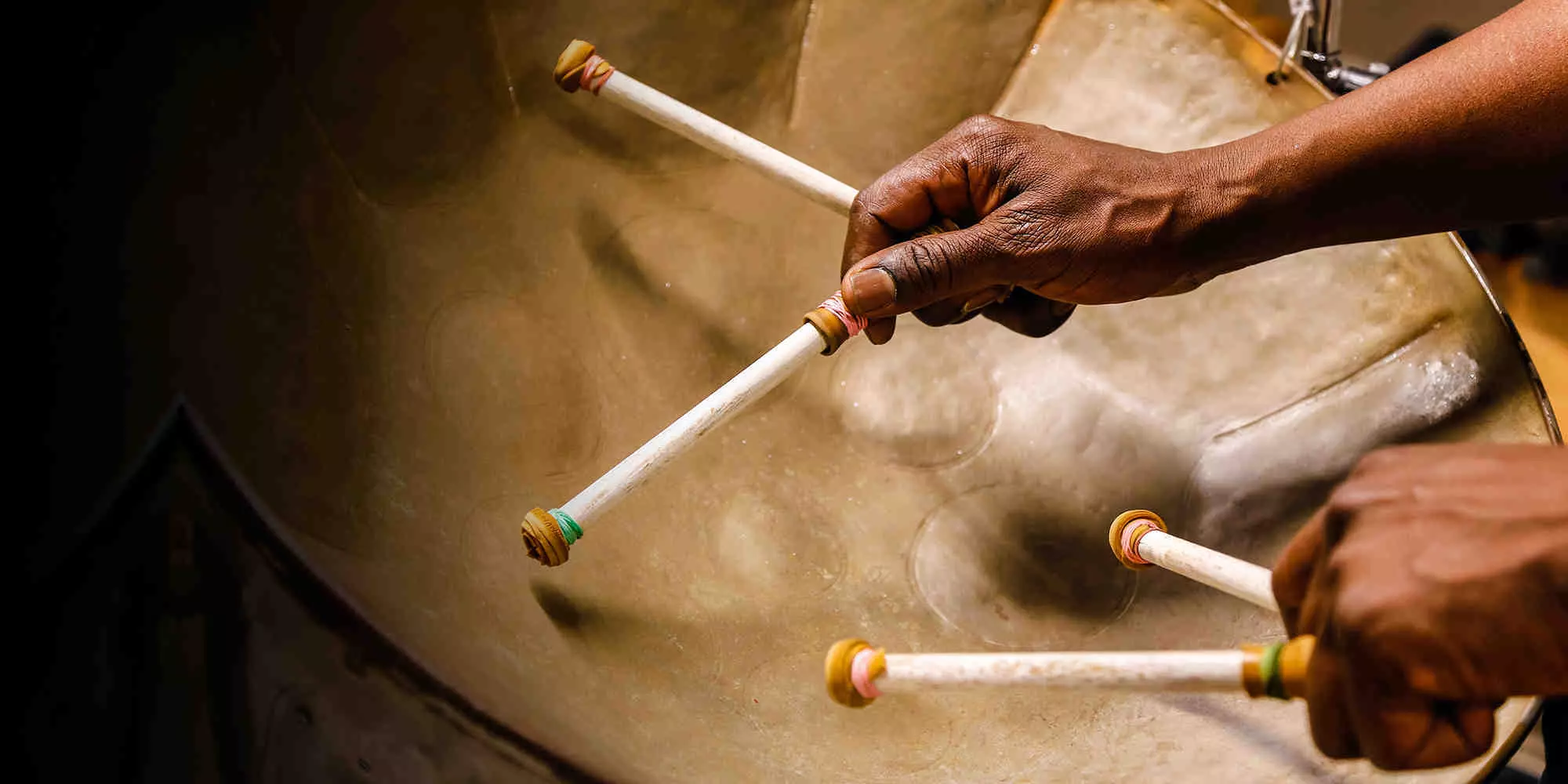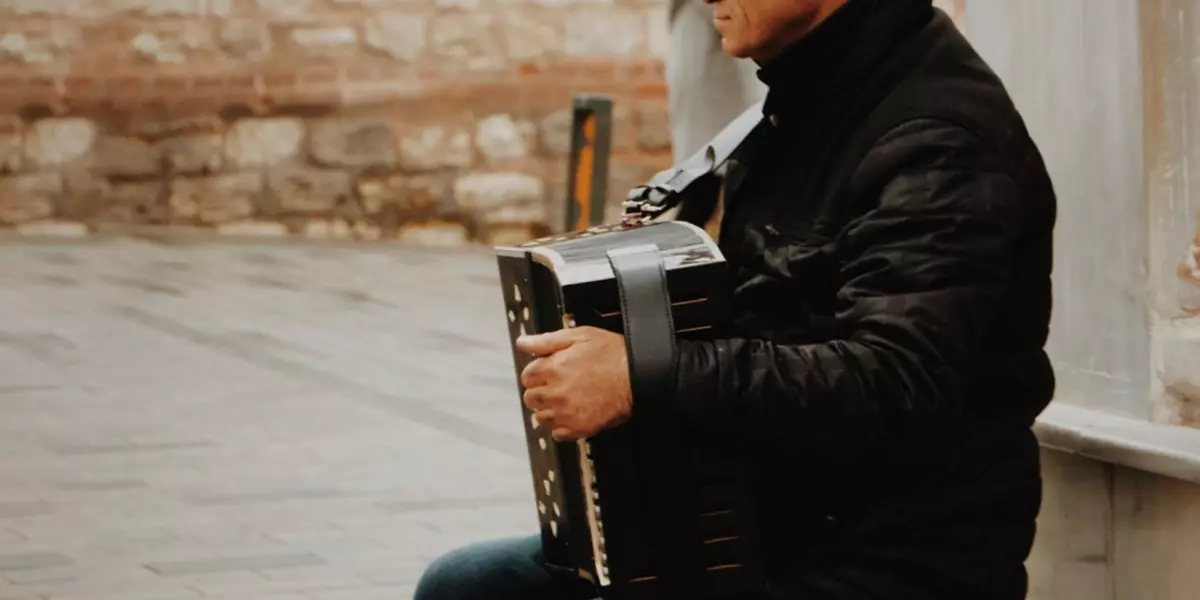How to Play the Cajon: Everything You Need to Know

Last Updated: December 1, 2025
Is it a box? Is it a drum?? Is it a seat??? Surprise - it’s all three!
There are many ways to use this versatile instrument. This blog will focus on helpful information about how to play the cajon and its various playing styles.
The cajon is a box-shaped instrument played by percussively hitting its front and sides to produce sounds with your hands or fingers, or with an item such as a mallet or brush. Originating in Peru in the 1800s, it has seen a drastic increase in popularity, fabrication options, and styles in North America over the past 20+ years.
With a smaller footprint and lighter sound than an acoustic drum set, it is becoming a perfect option for stages in small venues, acoustic-styled covers, lighter styles of music, and more!
Playstyle & Components
Traditionally played by hand, the performer sits on the box, and the cajon is struck on the front faceplate to produce a sound that resonates inside and exits through the sound hole on the back.
Tones & Pitches
As with any other percussion instrument, the speed and force applied can help determine the volume and tone produced. There are also advanced striking techniques to push this point further using brushes, which will be discussed later in this blog.
Unlike a drum set, the cajon produces a fixed note because it lacks a pitch-tunable surface like a drumhead. The most challenging part of learning the cajon is finding the sound that matches your preferred pitch. This task is essential and enjoyable in learning how to play the cajon.
Materials Used in a Cajon
The type and size of wood used are key to determining the sound produced by the cajon, not just for looks. The most common types of wood used to make cajones are maple, birch, and oak. They need to be durable and sturdy enough to be sat on and struck multiple times. Other types of wood can be used for the front faceplate to give the instrument a distinct look.
Small rubber feet on the bottom prevent the box from sliding and provide more comfort and elevation of the instrument. Depending on the make and model of the cajon, a thin foam pad attached to the seat can offer more comfort during extended playtimes.
Thin metal wires (like a snare drum or guitar string) are attached inside different components of the cajon to produce alternate sounds when other areas of the cajon are struck. These elements, combined, make up what is widely known and accessible to most musicians as the “modern” cajon.
The Modern Innovation of the Cajon
As we all know, many things we enjoy today differ drastically from what they were like in the 1800s. Regarding music, many classical instruments have retained their designs throughout history to produce a distinct sound and playing style. However, the cajon is an instrument that has evolved with modern innovations, allowing it to be played in new ways.
Brushes
Cajon brushes are a recent innovation that allow percussionists to strike the cajon with a softer surface, generating a different sound. These brushes can also be a helpful tool to reduce the amount of wear and tear on the player’s hands.
Granite Percussion Cajon Brushes - Straight Nylon Bristle
Sitting Position
One notable caveat for some percussionists with a cajon is the slouching or leaning required to play, and the toll it can take on the back. Recently, more comfortable and easier-to-play lap-style cajons have been introduced and are becoming more popular and accessible to more players.
A slap-top cajon, like the example below, is designed for the musician to sit in a seat and have the cajon rest on their legs, bringing the striking surface closer to the player. This model cajon is slightly larger and features snares on both sides.
Meinl Turbo Slap-Top Cajon - Walnut
Sound Amplification
One issue that has been addressed in recent years is how the cajon amplifies sound.
You can now find cajon-specific pickups or instrument microphones with a cajon-mounting attachment to improve amplification. Some companies have made a pickup version model of the cajon with a quarter-inch output jack that you can simply plug in, much like an electric guitar, into a PA system or amplifier.
Meinl Pickup Woodcraft Series Cajon - Natural
Bigger Bass
Some musicians have steered away from the cajon, finding that it can’t reach specific audible notes, particularly in the lower bass register, which more closely resembles an acoustic drum set. Companies have innovated again and are offering specially ported cajon models to enhance the lower-pitched tone. An example of this is the Meinl Subwoofer Jumbo Bass Cajon - Walnut Frontplate.
Snare Wires
The addition of snare wires to the cajon has provided a different playing surface for the box, and further enhancements allow for changeable or tunable wires that can be tightened or loosened to adjust the vibration, or turned on or off at will.
Gon Bops Fiesta Cajon - Walnut
All of these recent innovations have greatly expanded the versatility of the cajon and offered more styles and types of players who can use it.
Acoustic Kit Additions
While some drummers keep it simple by playing the original cajon drum style, other drumming styles use drum set parts and pieces to use the cajon differently.
Bass Drum Pedals
The most popular and common approach to applying drum set parts to a cajon is using a bass drum pedal. Singers and songwriters, or one-person bands, more often use this method. A bass drum pedal is placed in front of the faceplate to function like a regular bass drum, producing a small, compact sound. Ensure a bracket for attachment and a soft beater effectively manage the thin faceplate.
Companies have created cajon-specific pedals that can be attached to the instrument and played by percussionists, freeing up a hand for different playing techniques or for other instruments.
Cymbals
On the treble side, using drum set cymbals, such as splashes, offers an innovative sound texture that captivates both performers and audiences. These cymbals are also played with hands, just like the cajon.
While many musicians have modified the cajon over the years, as music evolves, it is only a matter of time before we see more unique ways to approach this remarkable instrument.
Electronic Additions
Even the electronic world isn’t free from the cajon! DJs and electronic music have found their way into sample presets on drum machines, multi-pads, electronic drum sets, and more.
Bass Drum Pedals
The recent move to replace the acoustic bass drum pedal with an electronic version has further expanded the range of sounds you can play with the cajon. Plug into a module that outputs to an amplifier or PA system (or with built-in sounds), and you can trigger any sound you like with the pedal to enhance your playing.
Roland SPD::ONE KICK 22-Sound Percussion Pad
Digital Cajons
Further technological improvements have included releasing digital cajons with electronic percussion pads installed into the playing surface, a control panel on the side for further tweaking, and output into sound systems. The digital cajon creates the experience of a complete percussion set and drum kit.
Percussion Accessories
While there is no shortage of percussion instruments worldwide, some find a nice home alongside the cajon. Small items such as egg shakers, foot percussion, tambourines, and bells are an excellent way to add background sounds to a cajon. One hand can play these while the other hand plays the cajon to create distinct sounds.
Granite Percussion Foot Tambourine - Black
One concern cajon players have is the lack of quality and variety in the cajon bags and cases department. They have listened to musicians' feedback and improved their offerings for quality and variety regarding cases and bags for the cajon. The increased availability of cushions and practice pads has been a welcome addition for musicians.
My Drum Setup With a Cajon
Although it has evolved over the years, my current setup for a cajon performance includes the following:
- Pearl Cabana Cajon, SKU: 759287
- Dunlop Gel Egg Shaker, SKU: 68127
- Zildjian K Custom Dark 10” Splash, SKU: 127012
- Mapex Armory Black Boom Stand, SKU: 414069
- Roland SPD-One Kick, SKU: 503801
- Roland PM-200 Electronic Drum Amplifier, SKU: 517804
- Ahead Armor Deluxe Cajon Bag, SKU: 429635
- Area Rug
- Myer Cajon Pickup
- Behringer Passive DI Box
Besides an area rug and these specific pickup and DI boxes, most of the items I use are available through your local Long & McQuade!
How to Play the Cajon
When I perform with the cajon, I keep it as simple as possible and use many drum-set techniques in my style to create the sound I like.
- My right hand is most involved, as it typically alternates between the middle of the cajon for ‘bass’ hits and the top edge for ‘treble’ sounds like a hi-hat cymbal. It can be holding an egg shaker for a particular song or part of a song for some dynamic differences, and reaching out to hit my splash for the ‘crash’ effect that a standard drum set would produce.
- My left hand is the ‘snare’ hand and provides the critical backbeat. Sometimes, I roll my fingers across to give the drum a quick buzz or ghost-note-type accent.
- My right foot plays like a bass drum pedal on a drum set, and my Roland pedal gives the right amount of oomph to any required low-end.
- Lastly, my left foot is the only free foot, giving me balance while performing or tapping to help maintain time or stay in the zone while playing.
There is no right or wrong way to play the cajon. However, dedicating time to practice, as with any instrument, can significantly improve your technique in playing the cajon. Your effort will make all the difference in transforming the cajon into a powerful instrument that can be played in a group or solo.
Getting Started With a Cajon
Whether you choose to play on the classic acoustic drum kit or take the plunge with an electric setup, learning to play the cajon is a unique experience on a percussive instrument with tons of history. If hand percussion instruments are your instrument of choice, don't hesitate to check out the rich sounds of a djembe or conga.
For those who want to learn how to play a cajon but don't want to make the initial investment, Long & McQuade offers flexible cajon rentals at a reasonable cost! With easy renewal options, you can take the cajon home to experiment and learn to play the cajon on your own time. You can rent a cajon for as little as $3 a day!
------------
Kyle is a Sales & Rental Associate in the drum department at the Kingston, Ontario location. Once complete, he will be the store manager of the new location in Cornwall, Ontario. He is part of two bands: Days of Thieves and Master Nate & The Reprobates.
Kyle wishes to thank his parents for getting him started with music lessons, all the instructors and fellow musicians who have shared their knowledge with him over the years, his managers, Paul and Nathan, for giving him the ability to share his craft at the store, and all the bands and artists he has shared stage and studio with over the years.
If you are interested in taking lessons to learn how to play the drums, visit your local store’s lesson centre to discover their wide range of skilled instructors ready to teach you or your child today. More information can be found on our lessons page.















